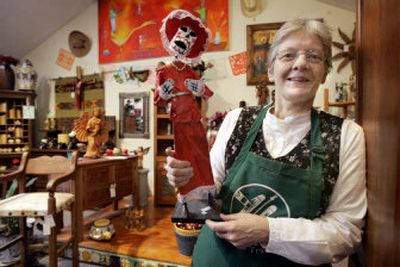Kinder global capitalists aim to share the wealth

ROCHESTER, N.Y. – Teresa Fritschi seeks out artisans in hidden corners of Scotland, pays generously for their lamb’s-wool blankets, Orkney driftwood chairs and organic-tweed jackets, and peddles their indigenous craftsmanship to a far-flung audience over the Internet.
James Potemkin is a kindred spirit who specializes in selling the rugs, furniture and art he finds in rural Mexico and Guatemala. And Raquel Marchenese fills up her One World Goods store with onyx from Pakistan, scorched gourds from Peru and scented soaps from a women’s cooperative in Chicago.
They are a new breed of kindhearted capitalists: In a cutthroat global economy, they not only pay their suppliers more, but help them ring up extra sales by tacking on comparatively low markups.
They share a passionate belief in fair trade, a fast-spreading phenomenon that aims to give businesses, cooperatives or solo artists in poor or marginalized parts of the world a higher price for what they create and a more direct route into lucrative markets in America, Europe and Asia.
Fritschi, 45, launched her Thistle & Broom venture last spring after losing a corporate marketing job and spending the next three years back home in western New York trying in vain to land another one. On a whim, she took a trip to Scotland and discovered its creative soul in locations as diverse as inner-city Glasgow and the Shetland and Orkney Islands.
Linking up with some 70 artists, many of whom have leaned on part-time jobs to earn a living, she began selling their one-of-a-kind apparel, tableware and textiles online.
What’s unusual about her burgeoning business, which she operates for now out of Edinburgh and a temporary home in New London, Conn., is her determination to pay her partners what they’re worth. They set their own prices – she sometimes has to prod them to charge more – and get 66 percent of the retail sale.
Fritschi said her usual 33 percent markups are far below the 200-plus percent norm in the homegrown-luxury-goods market. She expects to generate more than $100,000 in sales in her first year and intends to set aside 8 percent of her profits for cultural-heritage and conservation in Scotland.
“In the grand scheme of world economics, this is a drop in the bucket, but it’s important for people who wouldn’t normally be able to reach this kind of audience,” she said.
The fair trade movement sprouted in the United States after World War II and appears at last to be coming into its own after years as an activist-based niche.
While still comprising a fraction of commerce, fair trade is increasingly being tugged in front of mainstream audiences by organizations like Oakland, Calif.-based Transfair USA, which certifies fair-trade compliance for commodities ranging from coffee, and tea to sugar, rice and fresh fruits.
Those goods alone accounted for at least $500 million in U.S. sales last year, and $1.8 billion worldwide, said Transfair’s certification expert, Christopher Himes.
The best performer is fair trade coffee, which has captured nearly 2 percent of the U.S. coffee market, he said.
“We don’t want to make it harder to buy coffee or bananas or anything else,” Himes said. “We just want to make different options available for people who want to do the right thing but don’t really know how.”
Among the independent group’s certification requirements are that producers get stable minimum prices, don’t allow forced or child labor and use environmentally sound, sustainable methods of production.